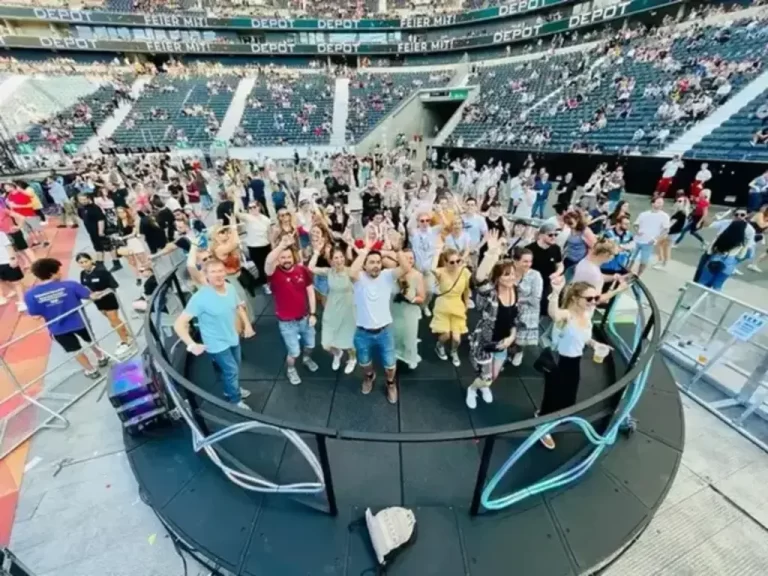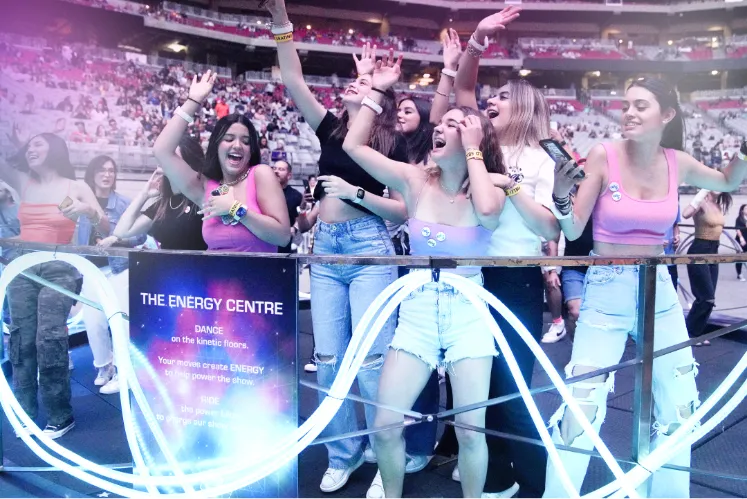Sustainable Dancing: gaining power from the audience's movement.
Does that help?

Power generating floor
Those going to the concert of the British pop band Coldplay can help provide electricity to the light show in person. Cycling on one of the bicycles, which for example, is connected to a battery system. But dancing is also possible: there are tiles on a special floor that collects kinetic energy from jumping concertgoers. The band is trying all kinds of things to make their world tour more sustainable. And making the audience an explicit part of it.
They are not the only ones. Since last month visitors have been supplying the SWG3 pop venue in Glasgow with heat pump energy. And the special “kinetic floors” had their premiere back in 2008 in Rotterdam, where the company Energy Floors installed the first ones. Especially now that energy prices are high, every bit of free electricity or heat is a nice bonus. But does it also save on energy bills and will it help sustainability?
Humans are only modest sources of energy, says Michel Smit of Energy Floors, which also provides Coldplay concerts with electricity-generating dance floor tiles. ‘We are used to using super much power. For your household, a concert, or your car, that’s really many times more than what you generate with your body.
Our floor tiles are a way to experience how much effort it takes to generate that much energy. That way, during a concert, you can communicate to the audience: the light show, that’s partly powered by your movements’!
Sustainable events
At the same time, Smit says his floor tiles are not necessarily irrelevant. In large numbers, he says, they can be very profitable. ‘If you were to fill a stadium completely with our tiles, theoretically you could have 20 thousand people jumping on them with lots of foot traffic and you could potentially power the whole show with 800-kilowatt hours using an installation like that. But people don’t jump all the time. Certainly, even at a Coldplay concert people shuffle a bit.’
In doing so, Smit assumes 10 to 20 watts of movement power per tile. That is realistic, says professor of thermophysiology Hein Daanen of the Free University. He calculates that if someone makes a “hop” ten times a minute from a height of 5 centimeters, about 5 watts of movement power can be tapped there. If they jump more often or higher, the tiles generate more electricity.
That power then goes into batteries: large lithium-ion cells, a type of battery similar to those used in electric cars. These store at least 90 percent of the clean energy, says battery professor Marnix Wagemaker of TU Delft, and have enough power for power peaks. ‘Today’s batteries are very fast and very efficient,’ he says. ‘Especially if you use the energy at short notice, such as at a concert, they should work very well.’

A fraction of the footprint
While Wagemaker does understand the importance of raising awareness, he is not entirely convinced of the plan’s sustainability. ‘You need a lot of raw materials and energy for such batteries, which in turn release a lot of greenhouse gas.’
How much renewable energy that’s generated by the kinetic energy floor tiles at Coldplay concerts, that’s a part that Smit cannot disclose, as the band has also paid to come out with the results themselves. He can, however, follow along remotely with what the tiles do. ‘The dancing audience at the concert in France delivered twice as much energy as in England. Things like that show that it does matter how mobile the audience is.’
By the way, the electricity bill is a fraction of the total footprint of such a concert. So other things can also be more sustainable, such as the journey the band and visitors take.
Body heat theoretically produces more than exercise. Because even a napping person needs to stay warm, it produces about 100 to 150 watts of heat. That soon becomes four to five times as much with vigorous exercise, says thermophysiologist Daanen, based in part on experiments on resistance cycling. That means that on an average stage at night, over a thousand heaters are roaring.
The club SWG3 in Glasgow wants to capture that heat through pipes in the floor and store it for later. A system like that is already being used in a few new neighbourhoods in the Netherlands, says sustainability professor Andy van den Dobbelsteen of TU Delft.
Harvesting renewable energy @ TivoliVredenburg
‘Perhaps the club could produce heat year-round during night-outs and use it to heat the building during the day. In a traditional situation, an air conditioner is bellowing and blows the heat out into the outside air, eliminating that useful heat.’ He calculates that if the club stores the heat from a thousand dancing people even just two days a week, it saves about 5,000 cubic meters of gas per year.
Exactly how much it will ultimately save remains to be seen. The system in Glasgow has only just become active and will be tested in the coming year with real concerts and dance events.
Music venue TivoliVredenburg in Utrecht also stores heat from the halls and reports that it certainly saves on heating costs but by no means all. Since prices went up, the energy bill has risen from 400.000 to 1.5 million euros, spokesperson Margot Kat says. ‘This technology suits us and we are always curious about new opportunities, but as a venue, you have to keep asking yourself if it is worth the investment.’
Indeed, how many such plans turn out favorably depends on cost, says Michel Smit of Energy Floors. ‘If you try something new and sustainable, it costs more money to run your club. The “standard” energy plan is the cheapest. But the standard one is not sustainable. Some innovations have an average payback period of seven or eight years. Not every club has that kind of money. That’s why I say: the innovations you see now show what is possible. If enough people dare to invest, it can become something big.’
